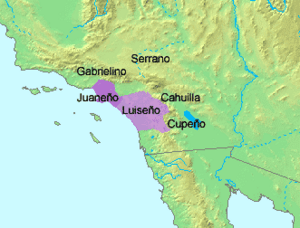Luiseño language facts for kids
Quick facts for kids Luiseño |
||||
|---|---|---|---|---|
| Chamꞌteela | ||||
| Native to | United States | |||
| Region | Southern California | |||
| Ethnicity | 2,500 Luiseño and Juaneño (2007) | |||
| Extinct | early 2010se25 | |||
| Language family |
Uto-Aztecan
|
|||
| Dialects |
Luiseño
Juaneño
|
|||
 |
||||
|
||||
The Luiseño language is a language from the Uto-Aztecan family. It was traditionally spoken by the Luiseño people. These Native American people lived in southern California.
When Europeans first arrived in the 1500s, the Luiseño people lived along the coast. Their territory stretched about 50 miles from southern Los Angeles County to northern San Diego County. It also went inland about 30 miles. The name "Luiseño" comes from their closeness to the Mission San Luis Rey de Francia.
Today, the Luiseño language is highly endangered. This means very few people still speak it. However, there are active projects to bring the language back to life. Linguists from the University of California, Riverside are helping with these efforts.
The Pechanga Indian Reservation offers language classes for children. In 2013, the tribe started funding a Luiseño class at California State University, San Bernardino. This is one of the few university courses for native languages in the country. In 2012, a Luiseño video game for the Nintendo DS was even used to teach young people.
The Juaneño dialect of Luiseño was spoken by the Juaneño people. This dialect is now extinct.
Contents
How Luiseño Words Are Built
Luiseño is an agglutinative language. This means words are often made by adding many small parts, called suffixes, to a main word. Imagine building a word like you build with LEGOs. You add different blocks (suffixes) to change the meaning or purpose of the word.
Sounds of Luiseño
The Luiseño language has a special set of sounds. These include different vowel and consonant sounds.
Vowel Sounds
Luiseño has ten main vowel sounds. Five of these are short, and five are long. Long vowels are held for a longer time when spoken.
For example, a short 'a' might sound like the 'a' in "cat." A long 'aa' would be held longer, like the 'a' in "father."
Consonant Sounds
Luiseño has many different consonant sounds. Some of these sounds are similar to English. Others are unique to Luiseño.
Some consonants are found only in words borrowed from other languages. These often come from Spanish or English.
Writing Luiseño
The Luiseño people have a rich oral tradition. This means they passed down stories and knowledge by speaking. They also have a written tradition that started a long time ago.
Early Writing Efforts
Pablo Tac (1822–1841) was a native Luiseño speaker. He was the first person to create a writing system for his language. He did this while studying to become a Catholic priest in Rome. His writing system was heavily influenced by Spanish, which he learned as a child.
Modern Luiseño Alphabet
Today, Luiseño does not have one official spelling system. However, a commonly used alphabet is taught in schools and colleges. This alphabet helps people learn and write the language.
The alphabet taught in schools includes these letters:
- ꞌ ꞌa ch ꞌe h ꞌi k kw l m n ng ꞌo p q qw r s s̸ sh th t ꞌu v w x xw y
Modern writing often uses an acute accent mark over a vowel. This shows which part of the word is stressed, or spoken with more emphasis. For example, in chilúy (meaning "speak Spanish"), the stress is on the 'u'.
Over time, different ways of writing Luiseño have been used. These have been influenced by Spanish, English, and other phonetic systems.
Sample Text: The Lord's Prayer
Here is a part of the Lord's Prayer (also known as the Our Father) in Luiseño. This version was written down in The Sparkman Grammar of Luiseño.
- Cham-naꞌ tuupanga aaukat cham-cha oi ohóꞌvanma.
- Toshngo om chaami.
- Lovíꞌi om hish mimchapun iváꞌ ooxng tuupanga axáninuk.
- Ovi om chaamik cham-naachaxoni choun teméti.
- Maaxaxan-up om chaamik hish aláxwichi chaam-loꞌxai ivianáninuk chaam-cha maaxaxma pomóomi chaami hish pom-loꞌxai aláxwichi.
- Tuusho kamíiꞌi chaami chaam-loꞌxai hish hichakati.
- Kwavcho om chaami.
Here is what these lines mean in English:
- Our-father / sky-in / being / we / you / believe / always.
- Command / you / us.
- Do / you / anything / whatever / here / earth-on / sky-in / as.
- Give / you / us-to / our-food / every / day.
- Pardon / you / us-to / anything / bad / our-doing / this as /we / pardon / them / us / anything / their-doing / bad.
- Not / allow / us / our-doing / anything / wicked.
- Care / you / us.
Recording the Language
In the 1930s, a linguist named John Peabody Harrington made recordings of Luiseño speakers. These recordings were saved on special metal disks. They are now kept at the United States National Archives.
These old recordings have been turned into digital files. You can now listen to them online through the Smithsonian Institution. This helps people learn about and study the Luiseño language.
See also
 In Spanish: Idioma luiseño para niños
In Spanish: Idioma luiseño para niños

